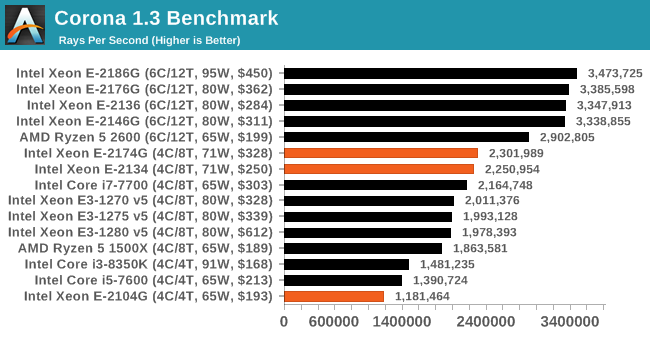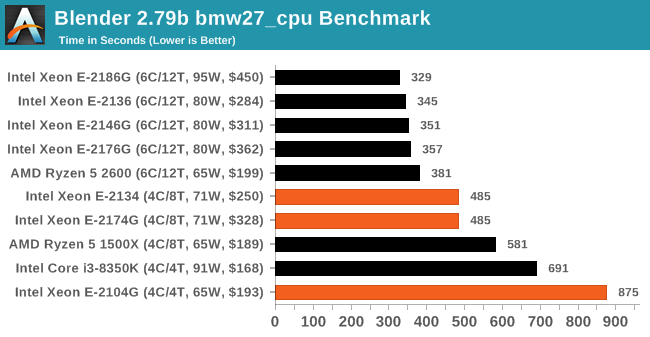The Xeon Entry Quad-Core CPU Review: Xeon E-2174G, E-2134, and E-2104G Tested
by Ian Cutress on March 11, 2019 10:30 AM EST- Posted in
- CPUs
- Xeon
- Enterprise CPUs
- Coffee Lake
- Xeon E
- C246
CPU Performance: Rendering Tests
Rendering is often a key target for processor workloads, lending itself to a professional environment. It comes in different formats as well, from 3D rendering through rasterization, such as games, or by ray tracing, and invokes the ability of the software to manage meshes, textures, collisions, aliasing, physics (in animations), and discarding unnecessary work. Most renderers offer CPU code paths, while a few use GPUs and select environments use FPGAs or dedicated ASICs. For big studios however, CPUs are still the hardware of choice.
All of our benchmark results can also be found in our benchmark engine, Bench.
Corona 1.3: Performance Render
An advanced performance based renderer for software such as 3ds Max and Cinema 4D, the Corona benchmark renders a generated scene as a standard under its 1.3 software version. Normally the GUI implementation of the benchmark shows the scene being built, and allows the user to upload the result as a ‘time to complete’.
We got in contact with the developer who gave us a command line version of the benchmark that does a direct output of results. Rather than reporting time, we report the average number of rays per second across six runs, as the performance scaling of a result per unit time is typically visually easier to understand.
The Corona benchmark website can be found at https://corona-renderer.com/benchmark

With the rendering tests, all our quad-core Xeon E processors lose out to the respective cheaper Ryzen parts.
Blender 2.79b: 3D Creation Suite
A high profile rendering tool, Blender is open-source allowing for massive amounts of configurability, and is used by a number of high-profile animation studios worldwide. The organization recently released a Blender benchmark package, a couple of weeks after we had narrowed our Blender test for our new suite, however their test can take over an hour. For our results, we run one of the sub-tests in that suite through the command line - a standard ‘bmw27’ scene in CPU only mode, and measure the time to complete the render.
Blender can be downloaded at https://www.blender.org/download/

LuxMark v3.1: LuxRender via Different Code Paths
As stated at the top, there are many different ways to process rendering data: CPU, GPU, Accelerator, and others. On top of that, there are many frameworks and APIs in which to program, depending on how the software will be used. LuxMark, a benchmark developed using the LuxRender engine, offers several different scenes and APIs.
In our test, we run the simple ‘Ball’ scene on both the C++ and OpenCL code paths, but in CPU mode. This scene starts with a rough render and slowly improves the quality over two minutes, giving a final result in what is essentially an average ‘kilorays per second’.


POV-Ray 3.7.1: Ray Tracing
The Persistence of Vision ray tracing engine is another well-known benchmarking tool, which was in a state of relative hibernation until AMD released its Zen processors, to which suddenly both Intel and AMD were submitting code to the main branch of the open source project. For our test, we use the built-in benchmark for all-cores, called from the command line.
POV-Ray can be downloaded from http://www.povray.org/

The much cheaper Ryzen 5 2600 here gets a good perf/$ boost over any of the quad-core Xeon E processors, and with the right system, can have ECC enabled.











29 Comments
View All Comments
mode_13h - Monday, March 11, 2019 - link
Those interested in ECC-support should also consider Intel's Core i3 CPUs. Most of those also support ECC. Do check their site, to be certain:https://ark.intel.com/content/www/us/en/ark/search...
mode_13h - Monday, March 11, 2019 - link
Also, it should go without saying that you need to pair it with a motherboard with ECC support.mode_13h - Monday, March 11, 2019 - link
For instance, compare the E-2174G with the i3-8350K:https://ark.intel.com/content/www/us/en/ark/compar...
eastcoast_pete - Monday, March 11, 2019 - link
Thanks Ian! While I know that my following suggestion might be overly simple, I like to also look at the value for money, especially for business tech like that. To do so, I simply divide the benchmarks by the price, resulting in performance/$ . If nothing else, it makes it easier to compare hardware that is at least within a certain range. Doing that, the Ryzen 2600 is the overall price/performance champion, whereas the Xeon 2146G is the likely choice if more speed and other features become important. I don't see much upside in the premium four core (2174G) over the (cheaper and usually faster ) six core 2146G.eastcoast_pete - Monday, March 11, 2019 - link
This didn't make it into my comment:Question @Ian: I saw you mention the performance /price once in your article, but is there a way to show that" Bang for the Buck" in a summary graph? I believe it might help put things into perspective, especially when comparing CPUs or GPUs where the most expensive costs 2-3 times as much as the cheapest.
msroadkill612 - Tuesday, March 12, 2019 - link
The 2600 is on sale for 7 days at newegg for $165, but it seems the going regular price for it atm.msroadkill612 - Tuesday, March 12, 2019 - link
TLDR,but buyers should also consider cooling and mobo relative costs also. afaik, many, if not all intels have no cooler, whereas tha amd included ones are regarded as qyute decent if not overclocking.peevee - Tuesday, March 19, 2019 - link
What a terrible mess the whole Intel lineup is.bimuzubi - Sunday, December 8, 2019 - link
Definitely, but here the power envelope is important for the test, which Anandtech doesn't seem to give. It's quite worrisome how most of those Xeons are operating outside of their power envelope, that E-2174G that you are referring to is pulling 85W for a rated 71W, so Intel gives a P2 power limit. Why bother with the normal TDP then? The 2600 seems to be owning price/performance and TDP/performance. Question there is EEC memory support, and the guarantee/testing including with Xeons https://adultpornroll.com/category/asian-porn-tube... . That's why I mentioned including TR in the benchmarks, or at least the 2700X.